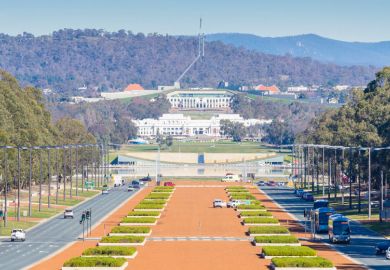Australia’s funding changes to arts degrees have already triggered course closures and will discourage study by underprivileged groups despite evidence that the humanities deliver job outcomes as good as those from science courses, an Australian forum has heard.
But conflicting evidence suggests that the changes will have minimal impact on humanities study even though arts graduates are “at an elevated risk of disappointing outcomes”.
Australian National University policy analyst Andrew Norton told a webinar that he was not convinced by predictions of decline in humanities study. “I’m a 30-year veteran of forecasts of doom for disadvantaged communities in higher education, and none of it has turned out to be the case – they’re participating at record levels,” he told La Trobe University’s “A farewell to arts?” forum.
Although the government’s reform package was “not desirable for social policy reasons, it’s not going to have a dramatic effect on the number of people who enrol”.
The forum heard that cuts to humanities offerings – including the axeing of musicology and theatre majors at Monash University, and La Trobe’s proposed scrapping of creative arts and language courses – were a taste of things to come. “Once you cut courses, it is very difficult to get them back,” said Joy Damousi, president of the Australian Academy of the Humanities.
She disagreed with Professor Norton’s assessment that the reforms, which will more than double tuition fees for most humanities and social science subjects, would have little effect on participation. “I don’t think that will be the case in regional and rural Australia [or] among low socio-economic students,” she said. “It will be more expensive to do Indigenous history than a medical degree.”
Aboriginal writer Celeste Liddle said Indigenous students would be heavily affected by the fee rises, with humanities study becoming largely the preserve of the elite. “We will see a growth in those who are able to pay,” she told the forum, although others would still take out debts to “live their dreams”.
Professor Norton agreed that the reforms’ impacts on Indigenous students was an “open question”, given the dearth of research into the price sensitivity of Aboriginal university applicants. But he said the prospects for arts courses largely depended on academics’ ability to attract students.
Universities would obtain more funding for humanities from tuition fees alone than from the combination of fees and subsidies under existing arrangements, he pointed out, and there were no limits on the number of unsubsidised students they could enrol.
He said Canberra was not imposing any restrictions on what universities could teach or what students could study – unlike the UK, where the government last year pledged to crack down on substandard university programmes, and universities are now developing ways to identify “low-value” courses to be merged or scrapped.
The forum heard that one of the government’s key justifications for raising humanities fees – that the courses delivered relatively poor job outcomes – was not supported by evidence. Data from the census and from this year’s Graduate Outcomes Survey suggest that employment rates may be marginally better for humanities than science, according to a fact checker service run by RMIT University and the broadcaster ABC.
But Professor Norton blogged that the proportion of graduates securing professional or managerial positions was lower for the humanities and social sciences than for other fields.
Register to continue
Why register?
- Registration is free and only takes a moment
- Once registered, you can read 3 articles a month
- Sign up for our newsletter
Subscribe
Or subscribe for unlimited access to:
- Unlimited access to news, views, insights & reviews
- Digital editions
- Digital access to THE’s university and college rankings analysis
Already registered or a current subscriber?










